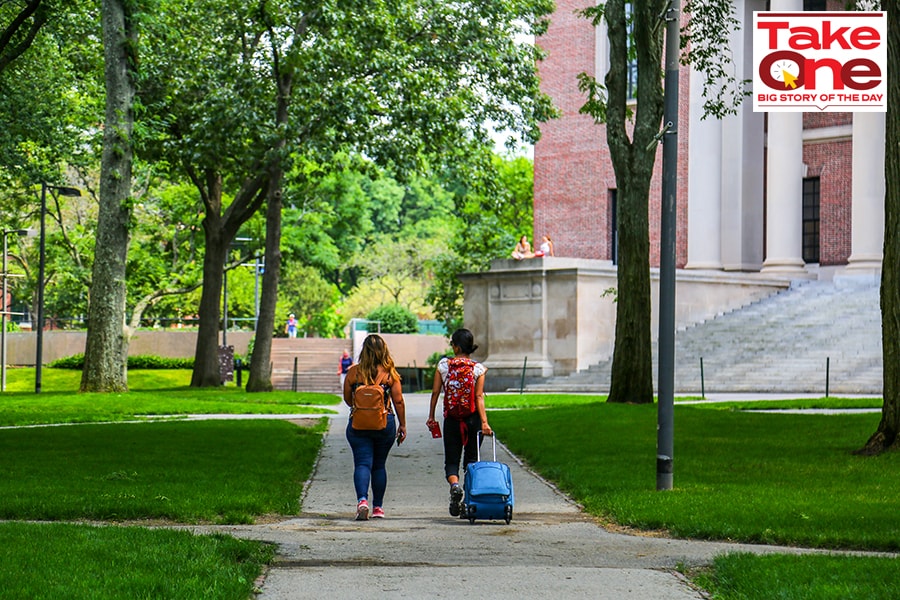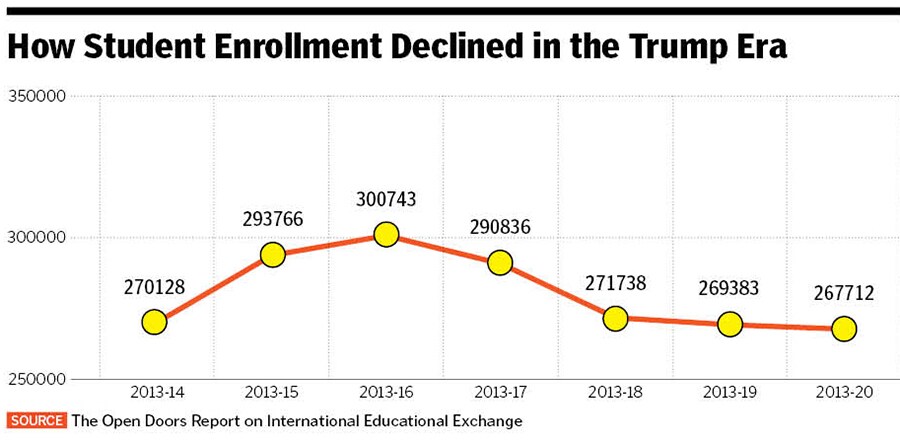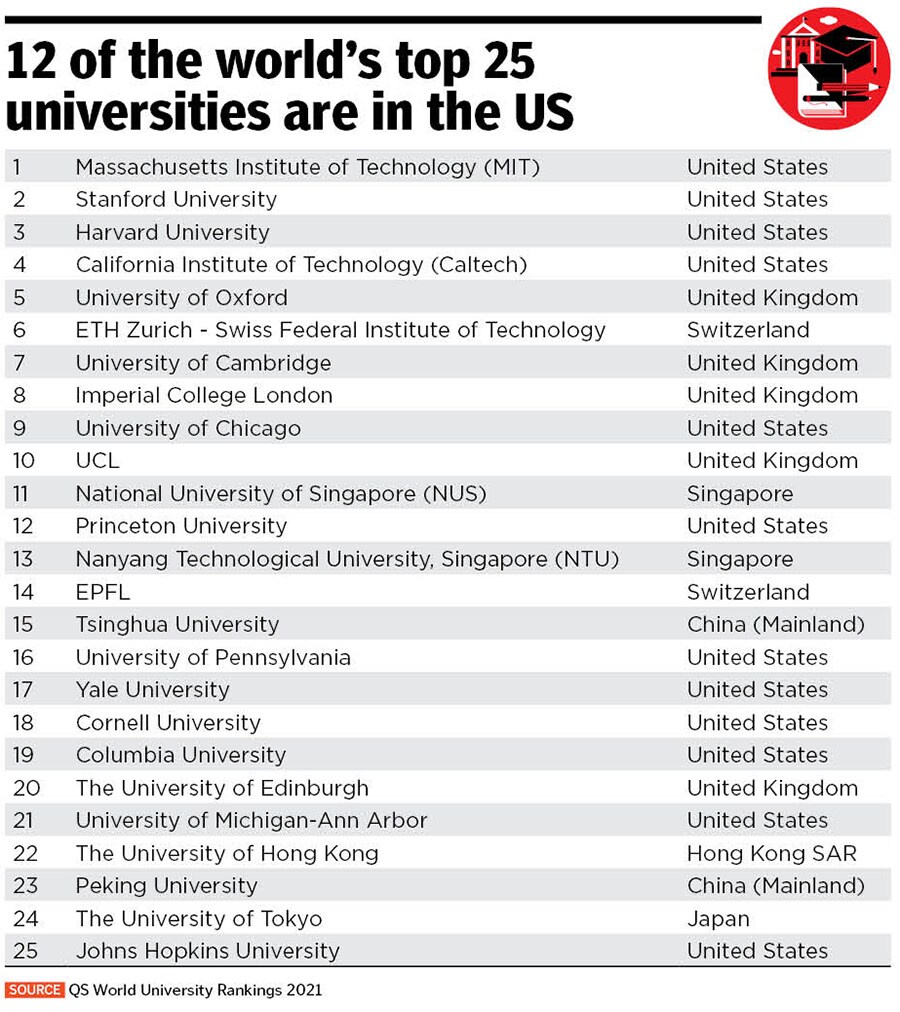Indian students, Uncle Sam wants you (once again)
Will the US under President Joe Biden regain its status of the 'Promised Land' for higher education?


 Two students are seen leaving their campus with baggage at Harvard University premises in Cambridge, MA, July 08, 2020.
Two students are seen leaving their campus with baggage at Harvard University premises in Cambridge, MA, July 08, 2020.
Image: Anik Rahman/NurPhoto via Getty Images
In August 2020, Kahan Shah, 25, completed his Masters in Finance from Boston College, Massachusetts, and began scouring for a job. When he applied for one with the finance department of an ecommerce platform, Reibus International in Georgia, Gujarat-born Shah was screened primarily on the basis of his current immigration status. “I applied to this one company, where they liked my application and I passed the preliminary screening process, but even before setting up the interview they enquired about my current immigration status and dropped me as they weren’t ready to provide sponsorship,” says Shah, who is on an F-1 student visa and would have required sponsorship for transferring to H-1B status.
“Where earlier a degree from a good US university used to open up multiple opportunities of getting placed in the country, under the Trump administration, the process of finding employment was much harder. Even after having all the necessary qualifications and experience, and applying to multiple places, the chances of getting placed were slim,” adds Shah.
Cut to Acha Chitkara, a 23-year-old from Haryana, who after completing schooling in India, graduated in Economics from The Hong Kong University of Science and Technology in 2019. Chitkara is now set to pursue a Masters in Finance at Duke University, North Carolina from July 2021. “I’m looking forward to studying in the US under the current administration. I think President Joe Biden and Vice President Kamala Harris will ease the immigration policies and visa restrictions, and that might make the US the first preference of Indian students,” says Chitkara.
Chitkara adds that many of his friends had deferred admission to American universities because of the political unrest during the Donald Trump administration. Their hope was that once Biden is elected to be president, they would renew their attempts for a seat in a US university.
A change in guard in the ‘Promised Land’ has once again made the US, which is home to over a fourth of the top 100 universities in the QS World University Rankings 2021, the preferred destination for higher education for Indians. The success of the American educational model has been apparent with a consistent rise in the number of international students opting to go there for higher studies till 2016.
Then came the dampener. Under the federal policy changes proposed by Trump during his four years in office, international students faced newer administrative hurdles and intense scrutiny over the visa application process and permit programs meant to enable students to work in the US after graduating college. Because of the increased restrictions, even employers started to recruit fewer international students. However, the Joe Biden administration aims to reverse the trend.
The Trump Era
US varsities, which have long held the stance for being welcoming and inclusive platforms that honour diversity, faced numerous problems under the Trump administration as the universities" perspective didn’t align with the government’s intent. Since 2016, the federal policy changes, coupled with increased cases of intolerance and racial discrimination, resulted in the country recording a decreased international student inflow over the last four years.

In the 2018-19 academic year, new enrollment of international students at US universities was 10.4 percent lower than in 2015-16, and 2019-20 marked the fourth academic year in a row where the number of international students enrolled at US colleges and universities declined, according to data released in November 2020 by the US Department of State and the Institute of International Education.
Under the federal policy changes proposed by Trump in his four years in office, as mentioned earlier, newer administrative hurdles and intense scrutiny meant even employers wanted to hire fewer international students.
Like in Shah’s case, the job application of Riyan Arora (name changed on request) was rejected because he was an international student. “Back in November 2019, after graduation, I was applying for jobs one company rejected my application by stating on e-mail that I was being rejected because I wasn’t a US citizen.” For Arora, this was a precursor to shift back to India. “At least in India, my nationality doesn’t determine my prospects of securing a job,” he adds.
The Covid-19 pandemic only made matters worse. In July 2020, the Department of Homeland Security proposed a directive where, to reside in the US, international students would have needed to transfer schools or leave the country if their colleges held online classes entirely because of the coronavirus lockdowns. The directive was rescinded within a week in response to lawsuits filed by colleges like Harvard and Massachusetts Institute of Technology (MIT).
“This bill would have forced all the international students who weren’t enrolled in an in-person course to leave the US. A lot of my friends who had rented apartments here on a two-year lease, panicked since there was no way they could have afforded relocating to their home countries. Trump’s policies made being an international student really dicey. Every day, we felt an enormous pressure of not knowing what could be next,” says Gaurav Khosla, a bachelor of arts in theatre and politics student at The New School, a research university in New York.
The Institute of International Education partnered with nine higher education associations to assess international student enrollment amid the Covid-19 crisis. The survey concluded a 43 percent drop in new international student enrollment and a 16 percent reduction in total international enrollment in the fall of 2020.“The major reason why students travel overseas is the opportunity to get a work visa and jobs, which under the Trump administration, seemed like a very difficult option. That is why many students shied away from going to the US,” says Sharad Mehra, CEO-Asia Pacific, Global University Systems (GUS), a network of higher-education institutions around the world.
The study also found that one in five international students are reportedly studying online from abroad amid Covid-19, and roughly 40,000 international students have chosen to defer their enrollment to a future term. The countries that have been the top beneficiaries of the political unrest in the US are UK, Germany, Canada, and Australia. Indian students studying at Canadian universities rose from 76,075 in 2016 to 172,625 in 2018, an increase of 127 percent, according to the Canadian Bureau for International Education. In the UK, the government"s post-Brexit immigration policies have made it easier for international students to remain in the UK and work at any skill level for two years after completing their studies.
“The enrollment ratio in these countries has gone up because of two primary reasons: the US not being a viable option amid increased restrictions and that these countries are work visa friendly and would let the students explore the possibility of eventually settling in the country without the constant pressure of being expelled,” Mehra says.
The Biden Effect
Biden and Harris have shown an inclination towards rebuilding the welcoming image of the US. In the run-up to the election, Biden had tweeted in July: “Across the world, people come to this country with unrelenting optimism and determination toward the future. They study, here, innovate here, they make America who we are. Donald Trump doesn’t get that – we need a President who does.”
Within the first seven days of taking office, Biden signed 39 executive orders aiming to reduce or reverse the Trump-era regulations. One of the orders is a comprehensive immigration reform, which, among other provisions, would make it possible for more international Ph.D. graduates in STEM fields to stay in the US. Another order seeks to end the ban on travelers, including students and scholars, from half a dozen Muslim-dominated countries.
A pre-election poll conducted by Graduate Management Admission Council (GMAC), an international non-profit organisation, showed that around a quarter of international candidates (24 percent) would be more likely to pursue graduate management education in the US if Biden came to power. Some 43 percent international candidates in the survey indicated that they would not have pursued a US degree if Trump was re-elected.

“The top Ivy League universities haven’t been as adversely affected as the mid-tier universities. With the new administration, the hope is that slowly and gradually the international student enrollment will start going up, that’s the conversations we’ve had so far with such universities,” says GUS’s Mehra.
“The number of people enquiring about higher education possibilities in the US has increased a lot since Joe Biden won the election. A lot of students and parents who had earlier decided against the US, with the new administration are hopeful about education in the country and have started the application process. There is a definite uptick in the number of students who will be applying this year on,” says Ileshaa Khatau founder of Uncommon Essay Girl, a higher education counseling service.
Non-profit association of international educators NAFSA’s economic analysis showed that international students contributed $38.7 billion to the US economy during the 2019-20 academic year, and supported nearly 416,000 jobs international students studying at community colleges contributed $2.3 billion and support 12,116 jobs. “International students are a huge revenue market for the US, so from the financial point of view too, I think the government will focus on maintaining the high levels of student inflow,” says Khatau.
The India Opportunity
“I wanted to study in the US, but the multiple instances of civil unrest and discrimination made me opt for a college in India. While there have been some definite perks of studying in India, I feel my friends who are currently in the US have access to much more than I do. But I’m hopeful about the [India’s] New Education Policy and would want to see where it takes the Indian universities,” says Shreya Sharma, who is pursuing bachelors in business administration from Sri Aurobindo College of Commerce and Management, Ludhiana.
In 2019, India was home to 47,427 international students from 164 countries, including 1,518 from the US. And in 2018-2019, the US had 202,014 Indian students. The focus on theoretical knowledge over practical experience is one of the primary reasons why the top Indian universities lag in the world rankings. “The primary reason to choose the US as the study destination is that it offers a much comprehensive approach in their courses and it is easier to find meaningful and gainful employment in the US as compared to India,” says Shah, adding that the improved standard of living is a big plus too.
Under the National Education Policy, 2020, along with a number of major structural changes, India aims to increase its global presence and the inflow of international students. As per the NEP, top foreign universities will be encouraged to operate in India, and Indian universities will be encouraged to set campuses abroad. The University Grants Commission (UGC) has given the green flag to the Institutes of Eminence (IoE) to set up off-shore campuses, including Indian Institute of Technology (IIT) Delhi, Indian Institute of Science (IIsc) Bangalore, Jadavpur University Kolkata, IIT Bombay, and IIT Madras. The UGC has also directed all universities to set up an office for international affairs to promote India as a global study hub.
“India needs to build its communication strategy for the world if it wants to attract more international students. The NEP is a vision board in the right direction, which, when implemented properly might not only improve the education scenario in the country but would also put India on the map with other top universities,” says Mehra.
Till then, it’s once again advantage America for higher education.
First Published: Jan 29, 2021, 12:36
Subscribe Now